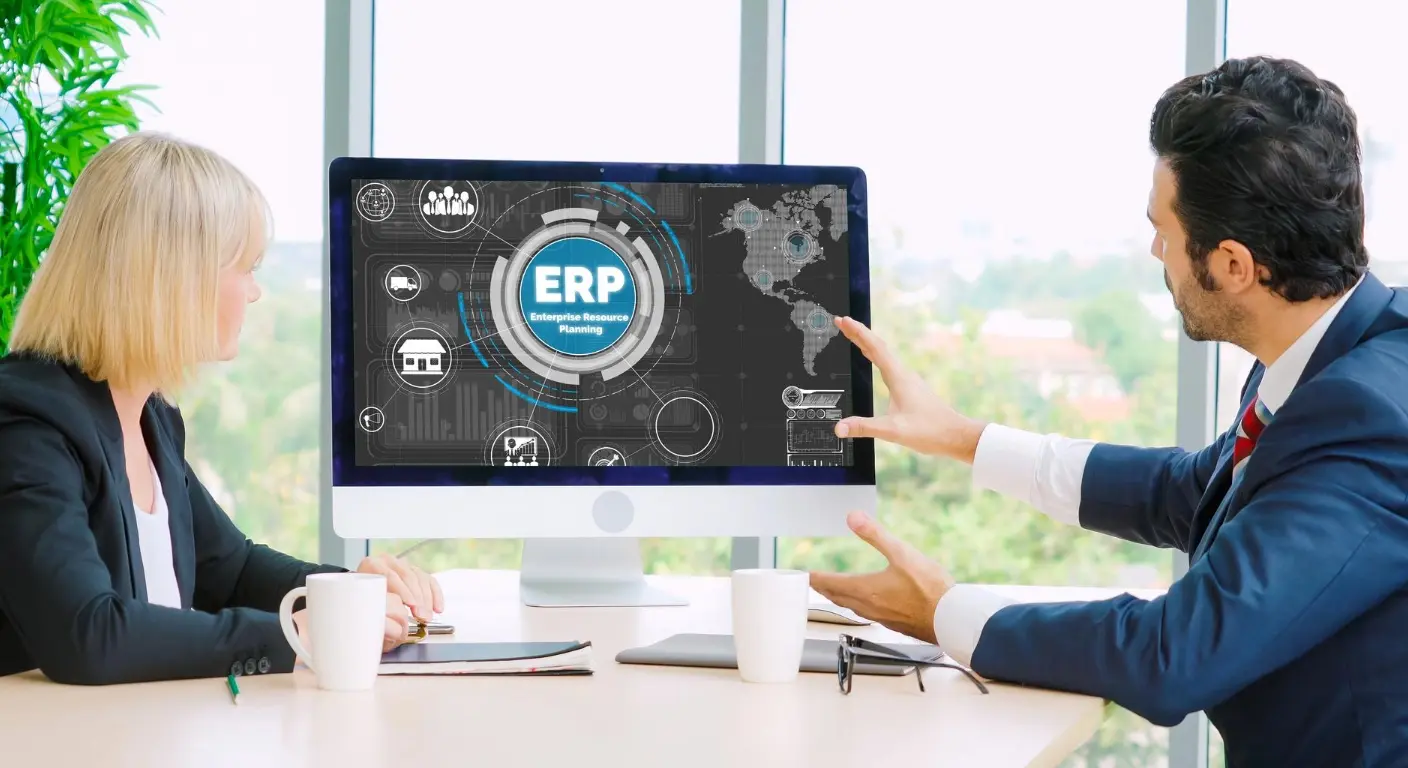

Enterprise architecture as a success factor in ERP selection: How to make the right decision

Why do 60% of all ERP projects fail? The underestimated role of enterprise ...
Why do 60% of all ERP projects fail? The underestimated role of enterprise architecture
Are you facing an ERP selection or migration? Then you know the challenge: How do you find the system that not only works today, but also makes your company future-proof for the next 10 years?
The answer lies in a systematic enterprise architecture approach. This guide will show you how to take the right architectural perspective:
-
Reduce technical debt (system inefficiencies) by up to 70%
-
Shorten your time-to-market by an average of 40%
-
Halve compliance efforts and increase your ability to innovate at the same time
The 6 architecture dimensions that determine success or failure
1. system & integration architecture: the foundation of your digital future
The crucial question: How seamlessly does the new ERP fit into your existing IT landscape?
What you need to evaluate:
-
API strategy: does the system have modern REST APIs or are you reliant on proprietary interfaces?
-
Real-time capability: Can critical business processes run without delay?
-
Legacy integration: How elegantly can legacy systems be connected or successively replaced?
Measurable success criteria:
-
Response time < 200ms for critical transactions
-
Maximum 30 minutes for new integrations (low-code/no-code)
-
Reduction of interfaces by at least 50%
2. data architecture: from data silos to a single source of truth
The crucial question: Will your ERP become a trustworthy data hub or just another silo?
What you need to evaluate:
-
Master data ownership: which system holds which master data?
-
Data quality: How are duplicates prevented and consistency ensured?
-
Analytics readiness: Is your data prepared for AI and advanced analytics?
Best practice: Define an enterprise data model with clear domains before making a selection. Companies with this preparation reduce migration errors by 92%.
3. process & capability architecture: from system to business capability
The crucial question: Does the ERP support your most important business capabilities end-to-end?
The paradigm shift: Think in terms of business capabilities, not modules:
-
Order-to-Cash instead of "sales module"
-
Procure-to-pay instead of "purchasing module"
-
Record-to-Report instead of "finance module"
Your benefit: Capability-oriented selection leads to 40% more process automation and 25% fewer manual workarounds.

4. technology stack & non-functionals: the invisible success factors
The crucial question: Does the ERP meet your technical standards for the next decade?
Critical evaluation points:
-
Cloud readiness: Multi-cloud capable or vendor lock-in?
-
Security architecture: Zero-trust compatible and GDPR-compliant by design?
-
Scalability: Linear scalability or performance cliff with growth?
Minimum requirements 2025:
-
Availability ≥ 99.9% (< 9h outage/year)
-
Automatic scaling up to 10x normal load
-
ISO 27001 & SOC 2 Type II certification
5. migration & transformation architecture: the secure path to the new system
The crucial question: How do you move from the old to the new system with minimal risk?
Proven migration strategies:
-
Strangler-fig pattern: gradual replacement instead of big bang
-
Event streaming: parallel operation with real-time synchronization
-
Shadow mode: New system runs but does not yet take over
Key performance indicator: Companies with a structured transition architecture have 85% less unplanned downtime during migration.
6 Governance & compliance: sustainability through clear rules of the game
The crucial question: How do you ensure that architecture decisions will still be correct in 5 years' time?
Essential governance elements:
-
Architecture Decision Records (ADR): Every deviation documented and justified
-
Principle-based design: clear guidelines instead of endless detailed rules
Continuous compliance: Automated checks instead of manual audits
Practical success story: How a wholesaler mastered its ERP transformation

The initial situation (2024)
-
25-year-old in-house development with 42 point-to-point interfaces
-
6 hours of downtime with each release
-
18% of all documents were processed manually
-
Annual IT costs: 2.8% of turnover
The transformation approach
Instead of a function-driven selection, our customer opted for an architecture-first approach:
-
Capability mapping: 3-stage business capability model as a basis for selection
-
API-first principle: Only systems with complete OpenAPI documentation
-
Staged migration: Core modules first, legacy system in read-only mode
-
Data quality sprint : 14-day "war room" before go-live
-
24-hour governance: Architecture decisions within one day
The result (2026)
-
ROI achieved after 22 months
-
Process throughput time reduced by 18
-
IT costs reduced to 1.9% of turnover
-
IT security audit without complaints
-
Zero downtime for updates thanks to blue-green deployment
Your checklist for architecture-driven ERP selection
Phase 1: Preparation (4-6 weeks)
☐ Document the system landscape (application portfolio management)
☐ Model business capabilities (not departments!)
☐ Classify integration requirements (real-time/batch/event)
☐ Define data domains and specify owners
Phase 2: Evaluation (6-8 weeks)
☐ Calculate architecture fit score for each provider
☐ Proof of concepts for critical integrations
☐ Performance tests under real load
☐ Security assessment by independent auditors
Phase 3: Decision (2-3 weeks)
☐ Calculate total cost of architecture over 10 years
☐ Evaluate migration risks in monetary terms
☐ Create architecture decision record
☐ Define transformation roadmap with quick wins
Frequently asked questions about architecture-oriented ERP selection
The 80/20 rule applies: 80% standard processes, 20% differentiating customisation. However, this 20% must be achievable via open architectures (APIs, events), not through core modifications.
The deployment option is secondary. The decisive factor is the architectural philosophy: API-first, event-driven, microservices-ready. A well-architected on-premise system can be more future-proof than a monolithic cloud ERP.
Three pillars of independence:
- Contractual exit services (data export, API documentation)
- Clean core strategy (no modifications to the standard)
- Integration via standards (REST, GraphQL, AsyncAPI)
AI is becoming a game changer through:
- Automated anomaly detection in processes
- Intelligent document processing (IDP)
- Predictive analytics for inventory optimisation
- Natural language interfaces for end users
Prerequisite: Clean data architecture and event streaming capabilities.
Allow 4-6 months for a well-informed decision. This may seem like a long time, but it will save you 12-18 months in implementation and years of technical debt.
Next steps: How to start your architecture-based ERP selection
1. Architecture readiness assessment (2 weeks)
Evaluate your current architecture readiness and identify areas for action.
2. Capability-based requirements engineering (4 weeks)
Translate business requirements into architectural capabilities.
3. Architecture-first RFP (2 weeks)
Create an RFP that prioritizes architectural fit over functional scope.

Why Dreher Consulting is the right partner for your ERP transformation
With over 20 years of experience in supporting medium-sized and large companies with ERP projects, we have developed a proven architecture-first approach that:
-
Reduces project risks by 65
-
Accelerates time-to-value by 40%
-
Creates sustainable architectures for 10+ years
Our consultants are certified in TOGAF, ArchiMate and the leading ERP platforms. We speak the language of both IT and business.
Arrange a free initial consultation
Let's have a 30-minute conversation to find out how an architecture-driven ERP selection can help your business.


/Herr_Dreher_500x500.jpg)




